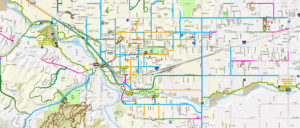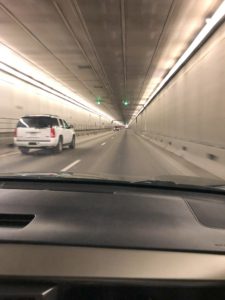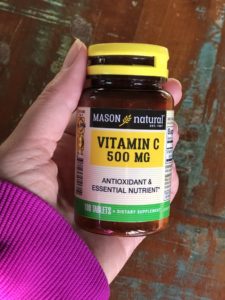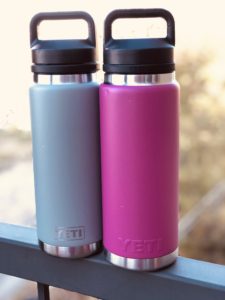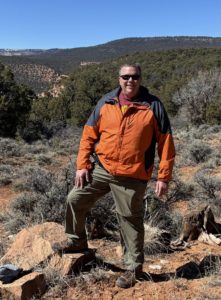What I learned in my first three months
Living in Grand Junction has been a better experience than my wife and I expected. There are lots of things to do in Grand Junction, Colorado that’s for sure! I want to share some things we’ve learned. They might help you, should you decide to live in Grand Junction, Palisade, Fruita or anywhere in Mesa County. Let me know what you think! Text/Call me anytime with your questions or share your story with me. 612-306-9558. I also post short videos and announce new website posts on our Facebook page called Live Your Vacation in Grand Junction.
 Save Money on Gas
Save Money on Gas
We moved from a suburban area with a population of 100,000+. It was a 20-minute drive to the mall with major department stores, or 10-15 minutes to closer cities that served most of our needs. However, living in Grand Junction is saving us money on gas. Where we are located, going to Target, the grocery store or the mall is under a 2-mile drive. Getting to Main Street downtown takes 10 minutes. Because everything is so close, we are spending way less on gas for everyday services. That was a surprise.
Gas prices seem average overall. City Market gives a discount on gas when you shop there. Get their app. And even better, save on gas throughout the Grand Valley when you use the Upside App. Use my code to get you an extra $.15/gallon cash back the first time you fill up. Use code: UK3UT.
Elevation vs. Population
In Minnesota, as you approached a new city along the Interstate, the sign included the population. In Colorado, elevation takes center stage over population on road signs. At first, I thought that was amusing, but now I find it quite helpful. Grand Junction’s elevation is officially 4,646’ above sea level. We are surrounded by the Book Cliff Mountains, the Colorado National Monument, and the Grand Mesa. All mountains that increase the elevation another 1,000 to 6,000+ feet higher. As you drive into the mountains its fun to realize your elevation, especially as you drive over the scenic mountain passes.
You might also like these posts: What is the Grand Valley and How to Avoid Altitude Sickness.
Grand Junction is Bike Friendly
Because of the warmer weather, people ride bikes year-round here. That means you’ll likely see bikers on your regular car outings so keep your eyes open. Stay vigilant. When you approach a stoplight and you want to turn right, stay back until you know the crosswalk is clear of bikers and pedestrians. And watch over your shoulder as bicyclists can come up behind you quickly. And never pull up too far at any stoplight, stay out of the crosswalk because there are people everywhere, especially downtown. The city has done a good job adding specific bike lanes alongside traffic to keep riders safe. Here’s a great map from Mesa County so you can see which major streets have bike lanes. The map also includes trails like the Colorado Riverfront Trail. Grand Junction Bike and Pedestrian Route Map
Community Focused
I am amazed at the number of events and activities going on in Fruita, Grand Junction, Palisade, and all over Mesa County. Everyone is very friendly here and always willing to share what they are up to. There are so many websites, Facebook pages and other social media accounts you can follow to find out what to do in the Grand Valley. Dining, outdoor adventures, wine tours, hiking, biking and so much more. I subscribe to many of the sites and pages and appreciate the advanced notice for upcoming events.
The Business Times is a local paper that helps keep me informed about business related community news. I also follow the Grand Junction Economic Partnership on LinkedIn and I subscribe to their newsletter. There are a lot of start-up businesses in the area and many remote work-from home professionals. You’ll find book clubs, professional organizations and so many recreational outings and clubs. There is no shortage of community involvement. And I didn’t even touch on the many wonderful nonprofit organizations!
Tourism is important to the Grand Valley. 30% of Grand Junction’s sales tax revenue comes from tourism. There are 6300 employed in the tourism industry in Mesa County. At a recent Western Colorado Economic Summit, I heard from city and tourism leaders from Fruita, Palisade and Grand Junction. They all commented that they keep a balance between tourism and community and that community (residents and businesses) always come first, tourism second. I like that philosophy! And the representative from Visit Grand Junction said the most common comment they hear from visitors is that the people of the Grand Valley are so friendly, that’s awesome!
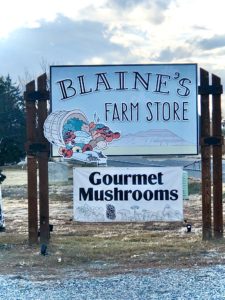
Blaine’s Farm Store near Palisade has fantastic produce and gifts
The Best Produce at Incredible Prices
There is so much local produce available for people living in Grand Junction. Of course, the Palisade peaches top the list, but the freshness and variety of plums, apples, pears and locally grown vegetables are all exceptional. When our daughter started at CMU, she said, “I don’t think I ever realized what a tree ripened pear tasted like until I started living in Grand Junction.” Amazing! I’ve also found that the prices on other produce not grown locally can be half the price I was paying in the Midwest and much fresher. Must be the proximity to California. Either way, be prepared to eat fresher, better, and less expensive produce when living in Grand Junction.
Everyone Has a Story
No matter who you talk to, everyone has a story about how they ended up living in Grand Junction. Some people attended Colorado Mesa University and never left. Others met their current partners elsewhere and came back home to live in Grand Junction. Some relocated for work or family, and many just fell in love with living the lifestyle the Grand Valley offers.
Every time I meet someone new, they ask what brought me to the Grand Valley. I always answer with “A desire to be closer to our children. And weather, and scenery, and quality of life, and location and the sense of community and the Palisade peaches and…” the list goes on and on! I’ve learned that almost everyone decided on living in Grand Junction for the quality of life, and the opportunity to enjoy the outdoors year-round and experience all four seasons.
Diverse Housing and New Construction
Living in Grand Junction, or anywhere in Mesa County, you have many choices for housing. In fact, we are finding it hard to choose exactly where we want to live in Grand Junction. Or maybe we end up in Fruita or Palisade. Modern, traditional, and historic homes coexist. Homes were first built in the late 1800’s or early 1900’s. We have an abundance of homes currently under construction today. Numerous neighborhoods and varying price ranges cater to different preferences. You can choose an urban lot, a little larger suburban lot, or there are lots of stunning acreage lots for sale in Grand Junction, Fruita, Palisade, Loma, Mack, Orchard Mesa, East Orchard Mesa and beyond.
What we have found helpful is to ask people where exactly they live in Mesa County and why. We want to know what they like and don’t like about where they live now. Ask me about homesteading in Whitewater along Kannah Creek! It’s really helping us to narrow down our geographic choices. When you look at sites like Realtor.com, just remember that not all properties are listed on the MLS or advertised on the Internet. I collaborate with local agents. I know when there are properties coming on the market well before the public knows. So, if you have certain criteria and you just aren’t finding it online, text or call me.
House Hacking is Alive and Well in Mesa County
If you are looking for ways to lower your monthly out of pocket expense for housing, then consider some of these house hacks. Many cities in Mesa County allow ADUs, an Accessory Dwelling Unit. That means you can legally have a second residence on your property. ADUs are allowed on single-family properties that are greater than 6,500 square feet in size. The size of the ADU is limited depending on the primary structure size. Call the Planning Department at 970-244-1636 with the address to discuss the limitations and process. The second unit could be a tiny house, a converted garage or other small structure. It’s a way to earn rental income to offset your housing costs. Read my post about ADUs in Grand Junction.
Another hack is roommates. Consider a property with a mother-in-law suite within the primary residence where your renter has their own private entrance. Or rent your spare bedrooms. You can even rent garage space or allow someone to store an RV on your property for a fee. All of it can create rental income to offset your cost of living. Many homes by Colorado Mesa University have been remodeled to maximize bedrooms and rental opportunities for landlords.
As I tour more properties in the Grand Valley, I see so much potential. Living in Grand Junction can be as diverse as you’d like it to be when it comes to housing.
The Temperature isn’t the Temperature
Adjusting to the Colorado desert climate involves understanding temperature nuances. Coming from the Midwest, we had to deal with humidity in the summer. Not as much as the southeast, but it made a difference. Ninety degrees and high humidity is not like ninety degrees with low humidity. The high desert allows me to enjoy those 90-degree days outdoors instead of wanting to stay inside with air conditioning. So far, the fall has been fabulous. December in the Grand Valley is like October in Minnesota. Every time we walk out the door, we are thankful to be here to enjoy the mild temps. Depending on where you are moving from, living in Grand Junction or Mesa County could be a big change for you too. I share the average monthly temperatures in my post called Grand Junction weather.
When it’s 40 degrees outside, I reach for my hat and gloves before I walk out the door, like I used to do. But so often, I don’t need them because 40 degrees feels warmer here than in the Midwest. The proximity to the sun at higher elevations intensifies its effects, makes it feel warmer than what we think it should feel like. When you step into the shade, you can really feel a drop in the temperature. We are still adjusting to it. Always dress in layers. And the locals have taught us, if you don’t like the weather, wait 15 minutes and it will change. And it does!
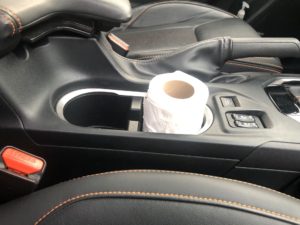
Always be prepared!
Keep Toilet Paper in Your Car
Yeah, this is a strange one. If you go exploring, you can’t count on a vault toilet or outhouse to have toilet paper for you or your passengers. And sometimes you are just lucky to have a facility at all. Road trip essentials. Keep toilet paper in your car, hand sanitizer or wipes, and other necessities that public restrooms might not supply. With the dryer weather, I also recommend some hand lotion. And it’s important to use sunscreen during the winter because the glare off the snow can cause sunburn. We keep extra sunglasses in our glove box for our “adventure trips” in case our passengers don’t have any. We stopped at many rest areas and visitor centers where there was no toilet paper. And remember, when you hike, pack it in and pack it out. Do not leave toilet paper in nature. Bring a bag for all of your trash. Oh, and if you haven’t been advised yet, bring lots of water!
Be sure to read my Top Day Trips from Grand Junction post where I share our personal experiences and tips for you. And the Grand Junction airport experience!
And, of course, Grand Junction isn’t perfect. You can read my post about some of the Cons of Living in Grand Junction.
Your Story
Discover your story in Grand Junction. Reach out to me at 612-306-9558 for more insights and guidance on making Grand Junction your home. Ask me about the time the sheep got out in Fruita and blocked traffic on I-70! I have plenty of stories to share. I’d love to show you around the Grand Valley and help you discover the perfect place to call home.
Live your vacation in Grand Junction!
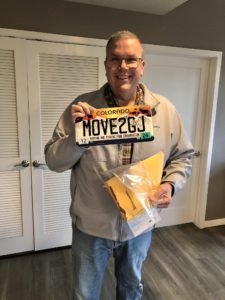
Check out my custom license plate!
Text/Call 612-306-9558 with your questions.
Paul Aspelin, Realtor®
GRI, SRES®, CNE
Serving Mesa County
© 2023 Paul Aspelin, REALTOR® MovetoGrandJunction.com. Copyright protected. All Rights Reserved. Licensed in Colorado.

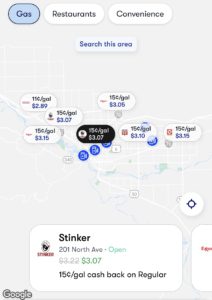 Save Money on Gas
Save Money on Gas